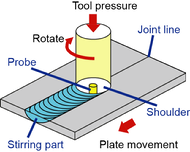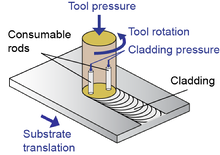Duration
Start: 01-09-2009
End: 01-09-2013
Partners
![]()


Staff
- ir. Arnoud van der Stelt (A.A.)
- dr.ir. Bert Geijselaers (H.J.M.)
- prof.dr.ir. Ton van den Boogaard (A.H.)
- dr.ir. Ton Bor (T.C.)
- prof.dr.ir. Remko Akkerman (R.)
Description
In this research an advanced solid state cladding process, based on Friction Stir Welding (FSW) is researched. FSW is a relatively new solid-state joining technology for metals, see Figure 1. It shows no solidification-related joint imperfections which makes it utmost suitable for hard-to-weld highly alloyed aerospace aluminum grades, like AA 2xxx and 7xxx. The developed process during this research project is entitled Friction Surface Cladding, see Figure 2 for a configuration without a central probe. The FSC technology enables the deposition of a solid-state coating using filler material on a substrate with good metallurgical bonding.

Figure 1: Schematic representation of the friction stir welding process

Figure 2: Schematic representation of the friction surface cladding process (FSC)
The FSC technology has the following potential advantages:
- Protective coating against wear and corrosion (see Figure 3).
- Increase of the weld strength.
- Welding of geometries which require addition material.
- Filling of the end hole.

Figure 3: Cross section of an AA2024 cladded plate with an AA1050 coating.
A prototype of the modified friction stir welding tool is produced, see Figure 1 and is continuously being developed with help of experiments. The weld properties strongly depend on the welding conditions. Important process parameters are the welding speed, the tool rotation rate and the applied down force. Also the type of tool and material grade play an important role. A thorough understanding of the material flow under the shoulder bottom of the rotating tool moving through the work piece is required to improve the weld quality and speed up the welding process.
Additional bonding experiments were performed during this project for quantifying the bonding behavior of aluminium to aluminium. These experiments were also simulated in the in-house Finite Element Software program DiekA.
